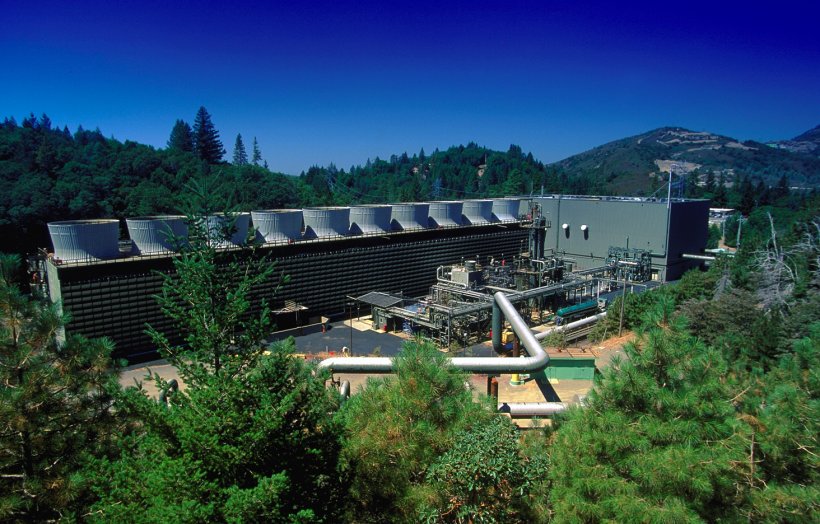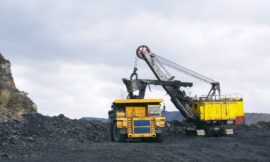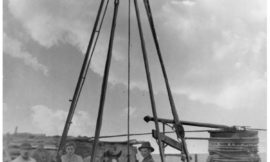Geothermal energy is a buzzword that is thrown around a lot but what exactly is it? Most people understand that it utilizes the heat found naturally underground. This is a type of renewable energy that mixes technology used in oil and gas exploration and production with typical steam turbines to generate electricity. In some states, mineral owners can benefit from geothermal development through a geothermal lease. Be sure to listen to the entire episode to learn how you might benefit from geothermal development.
Be sure to also subscribe on Apple Podcasts via the link above and please leave us an honest rating and review. We read every one of them and sincerely appreciate any feedback you have. To ask us a question to be featured on an upcoming episode, please leave a comment below or send an email to feedback@mineralrightspodcast.com.
What is Geothermal Energy?
Geothermal energy refers to the naturally occurring heat below the ground. You probably have heard that the sun is powered by a massive nuclear reaction but did you know that the Earth is also powered by nuclear energy. In fact, the primary contributor to the heat found in Earth’s core is from “the decay of radioactive elements, leftover heat from planetary formation, and heat released as the liquid outer core solidifies near its boundary with the inner core.” [National Geographic]
This nuclear reaction within Earth’s core “is the furnace of the geothermal gradient. The geothermal gradient measures the increase of heat and pressure in Earth’s interior. The geothermal gradient is about 25° Celsius per kilometer of depth (1° Fahrenheit per 70 feet).” [National Geographic]
This geothermal gradient is what enables the ability to heat up water into steam to power a turbine to generate electricity. That is exactly what geothermal energy is, where a well is drilled deep into the earth where it is hot enough to vaporize water into steam and then use the resulting high pressure and high temperature steam to spin a turbine to generate electricity at the surface.
How Does Geothermal Energy Work?
This technology is not new and is the principle technology used to generate electricity in nuclear power plants, natural gas power plants, concentrated solar power plants, even coal-fired power plants. That is, they use a fuel as a source of energy to heat up water into steam to spin a turbine to generate electricity.
This video from the Department of Energy’s Energy 101: Geothermal Energy series does a great job of illustrating how geothermal energy works.
What is especially useful about geothermal energy is that it can be used as a form of baseload power. Baseload power refers to a dependable, stable amount of electricity generation that can be used to consistently meet demand. These types of power sources are critically important because they can operate reliably at or near full load. So if a base load power station like a nuclear power plant, natural gas, or coal fired power plant has a nameplate capacity of 1 gigawatt, it means that it can produce a constant 1 gigawatt of power most of the time.
In fact, if we are to be successful in the energy transition moving away from fossil fuels while improving the standard of life of the billions of people without access to cheap and reliable electricity, we need reliable power sources. Geothermal is the only renewable energy source that can produce baseload power without the need of massive batteries or other energy storage methods. This solves what I think is the biggest technical challenge facing renewables is the ability to store energy so that when the wind isn’t blowing or the sun isn’t shining that we still have a reliable source of energy. Without this, if we transition to renewables too fast we will be faced with rolling blackouts and lack of available energy.
Geothermal energy is particularly useful in areas where the heat from the earth’s core is closer to the surface such as where the crust is thinner (like Yellowstone) or where tectonic plates meet like in Hawaii. In these areas, we only have to drill down a few thousand feet to get enough of a geothermal gradient for steam to generate electricity.
What this means is that in other areas, the geothermal gradient is too low to economically generate steam to power a generator or that it would require drilling so deep that we don’t yet have the technology to reliably drill several miles deep to tap into the heat required to run a geothermal power plant.
There is a great post by a group called Doomberg that talks about some high-profile startups that are addressing this technological challenge. If you can imagine having to drill 10 – 20 km deep, a standard rotary drilling rig won’t cut it. Companies like Quaise Energy are developing a hybrid drilling rig which uses a traditional rotary bit to drill a couple of kilometers down like we do today for oil and gas wells and then it uses a “gyrotron-powered energy beam to melt, fracture, and vaporize the tuff stuff”. Their CEO claims that it “will take just 100 days to deliver you a hole of 20km (12.4 miles) deep”.
Types of Geothermal Wells
- Deep Wells
- Enhanced Geothermal Systems (EGS)
- Other options being explored like utilizing existing oil and gas wells
The difference between conventional geothermal and enhanced geothermal systems is analogous to the difference between conventional and unconventional oil and gas drilling.
With conventional oil and gas exploration, seismic data is used to identify locations where there is a geologic structure that trapped oil and gas and a “reservoir” occurs. A vertical well is drilled down into the reservoir and there is enough porosity and permeability within the rock to allow the oil and gas to flow to the wellbore where it can be extracted. With unconventional oil and gas developments, horizontal drilling is combined with hydraulic fracturing to create a network of tiny cracks within the formation that allows the oil and gas to flow to the wellbore where it can be produced to the surface.
So it goes with geothermal, conventional geothermal utilizes natural fracturing within the rock to allow water that is pumped down to contact the rock to heat up so that it can be brought up to the surface to run a turbine either directly or to heat up a heat transfer fluid to spin a turbine.
Per the DOE, EGS projects capture power from intensely hot rocks, buried thousands of feet below the surface, that lack the permeability or fluid saturation found in naturally occurring geothermal systems. EGS technologies utilize directional drilling and pressurized water to enhance flow paths in the subsurface rock and create new reservoirs, capturing energy from resources that were once considered uneconomical or unrecoverable.
What they mean when they say “pressurized water to enhance flow paths in the subsurface rock” what they are really saying is using hydraulic fracturing to create the flowpaths in the subsurface rock like what is done with unconventional oil and gas wells. In this case, technology from exploiting tight shale formations to produce oil and gas is being used directly in enhanced geothermal applications.
In fact, the oilfield services company Schlumberger has a Geothermal Services division to serve the geothermal industry.
Which brings us to the use case of using existing oil and gas wells in an area with a high temperature gradient to either convert them to geothermal wells or to coproduce oil and gas and geothermal energy.
The conversion option is interesting because there are a lot of orphan wells in the US and some might be suitable for geothermal energy. These wells are not economic to produce oil and gas by themselves and many also produce a lot of hot water. If we could use that hot water to generate electricity while still maintaining production we can extend the life of these wells. Of course, well integrity would have to be good.
The coproduction option is also interesting because in a lot of cases produced water is re-injected underground through a waterflood or enhanced oil recovery. In situations where that water is really hot, you could extract that heat before reinjecting the water into the formation.
What is the potential for Geothermal Energy in the US
The US department of energy says that up to 10% of the current energy needs in the US could be met by Geothermal (this information was as of 2014). To put this in perspective, in 2020 geothermal capacity in the US was 3.673 gigawatts (GW) which is less than 1% of current U.S. energy capacity. So,it is not a silver bullet but could make up a significant part of the energy mix going forward and the fact remains that we will likely need all forms of energy to power us into the future.
All energy is good energy in my opinion so it would be great to see geothermal reach its full potential.
How does geothermal energy affect mineral owners?
In the short video clip from the Department of Energy, they showed an example of where sulfur was extracted from the water used for geothermal energy so it is very possible that mineral extraction will be a part of some geothermal power projects and whoever owns the mineral rights below the surface would be owed royalties on the sale of any minerals that are sold in the process.
But the interesting thing is that ownership of the geothermal rights varies greatly from state to state.
In many cases, the way each state defines geothermal resources dictates who owns these rights whereas in other states they leave it ambiguous and up to the courts to decide when a dispute arises.
Here are few examples of how states characterize geothermal resources:
- California says they are “the natural heat of the earth, the energy, in whatever form, below the surface of the earth present in, resulting from, or created by, or which may be extracted from, such natural heat, and all minerals in solution or other products obtained from naturally heated fluids, brines, associated gases, and steam, in whatever form, found below the surface of the earth, but excluding oil, hydrocarbon gas or other hydrocarbon substances.”
- Whereas Utah takes the stance that geothermal fluids are considered “any water and steam at temperatures greater than 120 degrees centigrade naturally present in a geothermal system. . . . Geothermal fluids are deemed to be a special kind of underground water resource, related to and potentially affecting other water resources of the state.”
Some common themes are that geothermal is considered natural heat, many states consider the products entrained in any fluids that are extracted as part of a geothermal energy part of geothermal resources (with the exception of oil and gas or other hydrocarbons), and that water is part and parcel of geothermal as the means of bringing the heat to the surface.
Interestingly, some states have a temperature threshold where something is considered a geothermal resource that requires a separate lease vs. part of the water rights.
The takeaway from all of this is that this is an area that is heavily dependent on the state you are in as to who is considered the owner of the geothermal resources below the ground. In some states like California, Hawaii, New Mexico, it is considered part of the mineral estate. In other cases it isn’t characterized or may be considered to be part of the surface estate unless the rights have been specifically reserved or conveyed. Finally, some states like Wyoming consider geothermal as part of the water rights as they define it as “Undergound water” … “including hot water and geothermal steam”.
Get Help
As we always say, when it comes to issues of property ownership and leasing you should consult with a competent attorney licensed to practice in the state where your property is located. This is especially true with geothermal as there is a lot of uncertainty at this point as to who actually holds title to geothermal resources (depending on the state). You may think you have the right to sign a Geothermal lease but it could be up to interpretation of case law if it is not clearly defined at the state level.
If you are purchasing property in an area with a lot of geothermal activity, a best practice is to perform a title search to understand if there have been any reservations that might affect ownership of the geothermal rights. Don’t just assume they are part of the property. Also, do some research to understand how your state characterizes geothermal.
Geothermal Lease Terms
If you are fortunate enough to own the geothermal rights in an area that is prospective for geothermal energy, then there is a lot to consider when negotiating terms of a private geothermal lease.
If you own the mineral rights I think it would be very important to ensure you specify that the oil and gas mineral rights are excluded, you would also want to consider things very similar to an oil and gas lease like the term of the lease, the royalty rate, the lease bonus or rent and whether it is paid upfront like in a paid-up oil and gas lease or if rent is due over time.
In doing the research for this episode, it appears that there a lot of options for how the royalty might be paid for geothermal energy, for federal leases there is an electricity royalty, state leases can provide for up to 10% of Gross Revenue.
It seems that the leases can cover all potential use cases for this energy from direct use, extraction of minerals like Lithium as part of the process of generating steam, royalty for any electricity generated and sold or royalty on any steam sold to a third party. It sounds like it can get really complex.
This is for information purposes only and should not be construed as legal advice, get help from an attorney when negotiating a geothermal lease!
To Recap:
- Geothermal Energy has a lot of promise
- Could supply up to 10% of reliable baseload energy needs in the US
- There is deep geothermal energy that would allow us to tap into this resource almost anywhere but the technology is still being developed to enable this in a reliable and economic fashion
- Enhanced Geothermal Energy combines technologies from oil and gas like hydraulic fracturing to improve efficiency and effectiveness.
- There is also some research being done to utilize existing oil and gas production or injection wells for geothermal resources.
- Ownership of geothermal depends on the state but if you are in a state where you own the geothermal rights there could be an opportunity to lease these rights for geothermal energy development.
Resources Mentioned in This Episode
- Geothermal Services | Schlumberger
- Chasing an Energy Moonshot
- Cost of Geothermal Power and Factors that Affect It
- core | National Geographic Society
- Geothermal Basics | Department of Energy
- Geothermal Leasing 101: Federal, State and Private Lands
- MRP 151: Types of Underground Injection Wells
Thanks for Listening!
To share your thoughts:
- Leave a comment or question below (we read each one and your question may be featured in a future episode)!
- Ask a question or leave us feedback via email.
To help out the show:
Click the Apple Podcasts Logo Above to leave us a rating & review. It really helps us reach those that need to hear this information and only takes a minute. We greatly appreciate it! Plus, you can get a shout out on a future episode!
Thanks again – until next time!




